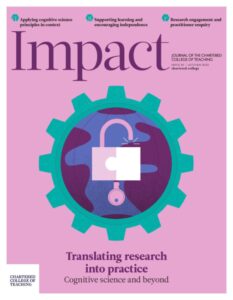Applying cognitive science principles to primary science
Written by: Sarah Earle and Kendra McMahon

7 min read
Dr Sarah Earle and Dr Kendra McMahon, School of Education, Bath Spa University, UK
Introduction
Cognitive science provides insights into learning that can inform practice in education, but the plethora of publications and, in some cases, the lab-based nature of studies that are remote from classroom realities make it difficult for practitioners to use this evidence to support or adjust their teaching. Considering subject-specific applications of cognitive science offers one way forward. In this article, we will explore two ways in which cognitive science principles can be applied to the teaching of science in the primary school. Approaches to managing cognitive load and retrieval practice will be exemplified, with reference to examples drawn from the Teacher Assessment in Primary Science (TAPS) project (web link in the references). TAPS works with teachers across the UK to co-research practice and co-develop resources to support the teaching and assessment of science in primary and E
Join us or sign in now to view the rest of this page
You're viewing this site as a guest, which only allows you to view a limited amount of content.
To view this page and get access to all our resources, join the Chartered College of Teaching (it's free for trainee teachers and half price for ECTs) or log in if you're already a member.
- Archer L, Dawson E, DeWitt J et al. (2015) ‘Science capital’: A conceptual, methodological, and empirical argument for extending bourdieusian notions of capital beyond the arts. Journal of Research in Science Teaching 56(3): 371–371.
- Bell D, Mareschal D and the UnLocke team (2021) UnLocke-ing learning in maths and science: The role of cognitive inhibition in developing counter-intuitive concepts. Journal of Emergent Science 20: 19–26.
- Deans for Impact (2015) The Science of Learning. Austin, TX: Deans for Impact. Available at: https://deansforimpact.org/wp-content/uploads/2016/12/The_Science_of_Learning.pdf (accessed 10 August 2022).
- Earle S (2021) Formative decision-making in response to primary science classroom assessment: What to do next? Frontiers in Education 5: 584200.
- Education Endowment Foundation (EEF) (2021) Cognitive science approaches in the classroom: A review of the evidence. Available at: https://educationendowmentfoundation.org.uk/public/files/Publications/Cognitive_science_approaches_in_the_classroom_-_A_review_of_the_evidence.pdf (accessed 22 July 2022).
- Furst E (2019) Meaning first. In Bridging (Neuro)Science & Education. Available at: https://sites.google.com/view/efratfurst/meaning-first (accessed 22 July 2022).
- McMahon K (2018) Assessment of working scientifically – the TAPS Focused Assessment approach. Primary Science 151: 15–16.
- McMahon K, Lee A and McKay D (2021) The learning sciences and primary school science. Bath Spa University. Available at: http://researchspace.bathspa.ac.uk/13965 (accessed 22 July 2022).
- Teacher Assessment in Primary Science (TAPS) (nd) Project resources. Primary Science Teaching Trust. Available at: https://pstt.org.uk/resources/curriculum-materials/assessment (accessed 22 July 2022).
- Sweller J (1988) Cognitive load during problem solving: effects on learning. Cognitive Science 12: 275–285.
- Sweller J (1994) Cognitive load theory, learning difficulty, and instructional design. Learning and Instruction 4: 295–312.
- Weinstein Y and Sumeraki M (2018) Understanding How We Learn: A Visual Guide. London: David Fulton Publishers. A summary is available here: www.learningscientists.org/book
- Willingham D (2009) Why Don’t Students Like School?: A Cognitive Scientist Answers Questions About How the Mind Works and What It Means for the Classroom. Hoboken, NJ: Wiley.
0
0
votes
Please Rate this content
Subscribe
Please login to comment
0 Comments
Oldest
Newest
Most Voted
Inline Feedbacks
View all comments










